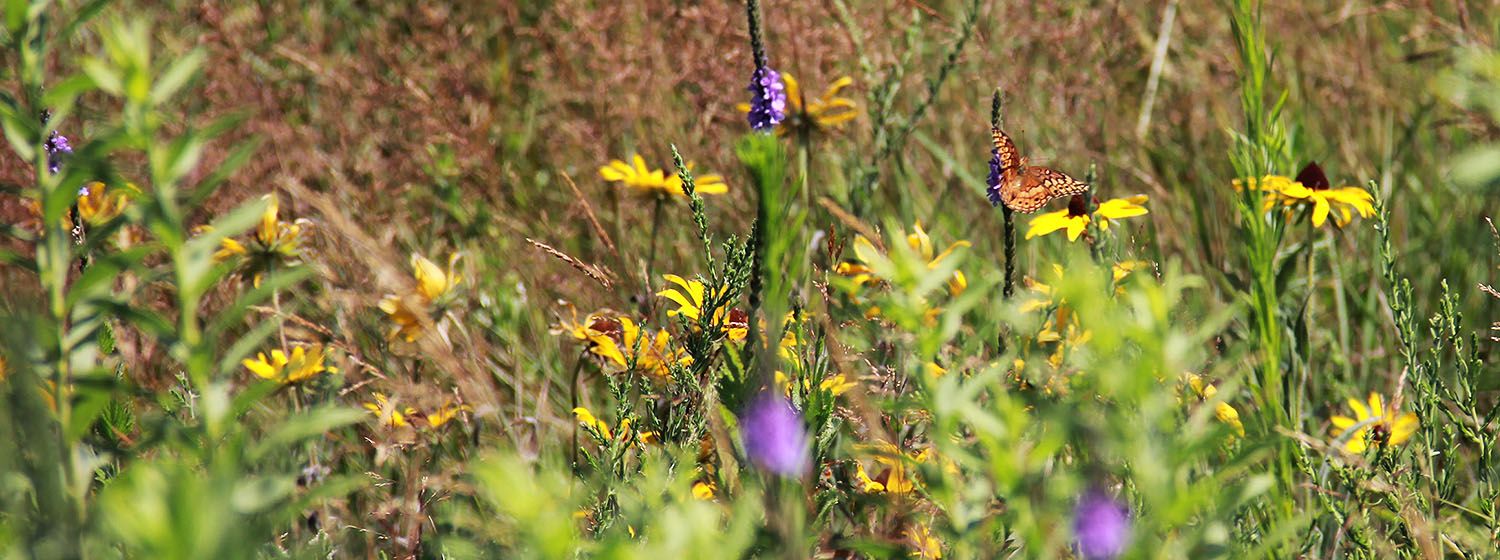When I took this job I did not think I would have to deal with so much poop! I mean I should’ve guessed what “collecting bison biometric data” on the job listing was a euphemism for, but ce la vie! Don’t get me wrong, poop is an incredibly useful biological tool! Whether you call it, “scat,” “feces,” or one of its less PG nicknames, this substance can be used to gain genetic information, determine who’s eating what, and examine the health of animal populations. All of this data can be collected passively without ever having to interact with animals, greatly decreasing the amount of stress wild animals are put under. Novices can even use scat to determine which species are present! Just looking at my camera roll, I have an unusual number of pictures of turds, which I keep telling myself I’ll eventually determine which species each is from. Nonetheless, I still wasn’t prepared.
The first assignment Emma and I were given as fellows was examining bison poop for parasites. To get a more in-depth explanation of how and why we do this, check out last year’s fellow's blog here or watch a short video from our Instagram page here! The basic process involves mixing fecal samples with water and chemicals, then using a microscope to count how many tapeworm, whipworm, and nematode eggs we see. We do the sampling 3 times a year. Once in May at the start of the growing season (right when the new fellows arrive), once in August towards the end of the growing season (right now), then again in December during the annual bison working. It took a little bit of practice, but by the end of it, we could scan a slide in 45 minutes. Josh Weise, our resident bison fecal parasite expert, can scan a slide in 15 minutes, so we have some improvements to make for the upcoming samplings this month!
It was pretty cool to use the microscope and look at microorganisms. There’s this whole tiny world filled with life that we don’t usually get to see. It makes me think of the multitude of itty bitty universes we ignore in our daily lives. As much as I hate using microscopes (it takes a delicate hand which I greatly lack), I’m so grateful for these tools. There’s just so much diversity we would never know even existed without these tools!
Outside of looking for parasites, poo has also become an important tool in our upland fossorial macroinvertebrate sampling.
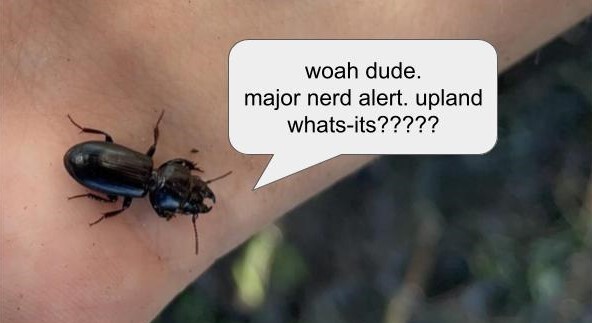
Wow Scarites beetle we found during sampling! You’re right! Those are some big words that most people don’t know, so let’s break down what exactly that all means. “Upland” refers to non-wetland habitats, so the typical tallgrass prairies most people imagine. “Fossorial” refers to critters that live underground and are one with the soil. Finally, “macroinvertebrate” refers to any animal without a backbone that you can see with just your naked eye.
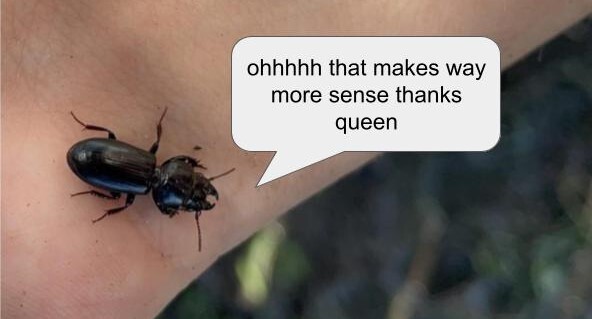
Happy to help!
So in order to find fossorial macroinvertebrates (like our curious friend), we have to look underground. Shocking, I know. This involves digging a 20 cm by 20cm by 20 cm hole out in the middle of the prairie then bagging up all the soil. Leaving a huge pit is a tripping hazard for future us, so it’s important to fill in these holes. With all of the soil being removed from the site, we have to improvise to find something to fill in the holes. Enter poop! Or as I like to call it, nutrient-dense pre-soil!
Bison and cows create the best fill, since they produce so much, uh, “pre-soil.” Scooping poop surprisingly creates opportunities to find some cool critters! My first day on fill duty, I found a whole bunch of gigantic scarab beetle larvae under some patties! Another common insect is of course the adorable dung beetle. Outside of bugs, it's also common to find snakes hiding amongst the doo-doo. Abe Kanz, the new Director of Conservation Research, once found a smooth green snake, one of the rarest snakes in Nebraska, just chilling underneath a cowpie. It’s hypothesized that snakes like to use the patties as cover from predators or as a place to warm up. So many critters make poop their homes that we’ve even seen sandhill cranes digging through dried patties to forage for tasty grubs or snakes (Carroll 1999).
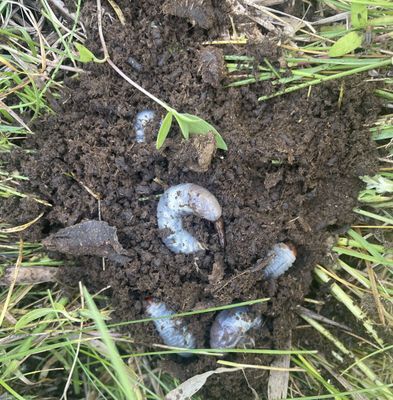
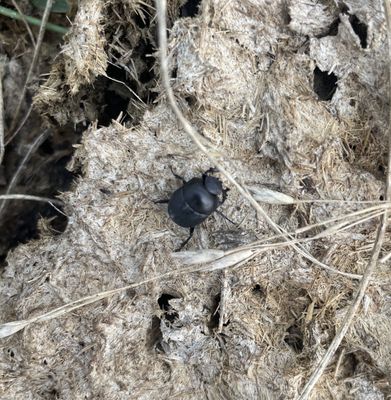
Scarab Beetle Larvae are pictured on the left. Dung Beetle pictured on right
I never thought my job would involve this much scat, but honestly I’m not complaining. Nature is truly incredible the way it can take one creature’s waste and turn it into another creature’s main food source. From plants to insects to fungi, all types of organisms depend on the nutrients from waste products to help build back the ecosystem. Everything plays an important role in shaping the beautiful complex ecosystems we love, even the crappiest of materials.
See you in the next blog!
Eleanor Muzzy,
Saunders Conservation Fellow
emuzzy@cranetrust.org
ReferencesCarroll, L. C. (1999). Use of grazed and non-grazed fields by wintering Sandhill Cranes and nesting dabbling ducks. [Master’s Dissertation, California State Polytechnic University, Humboldt] The California State University http://hdl.handle.net/2148/745
Pictures taken by me
